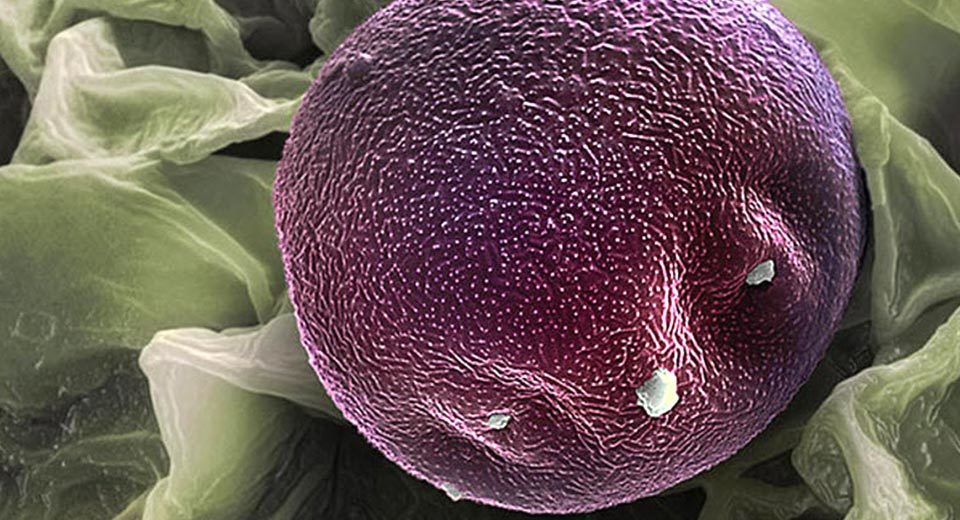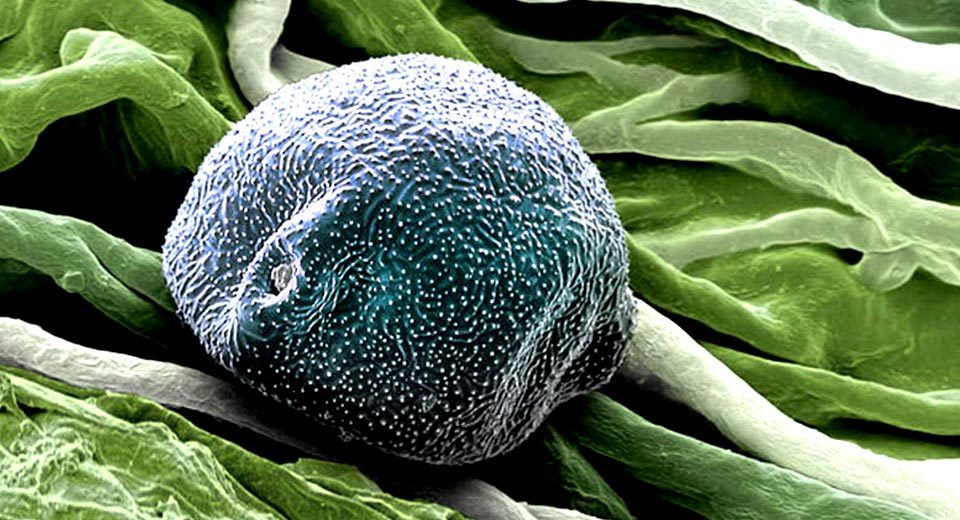How much pollen is in the air and what kind of pollen is allergic
Allergy season 2016 is open: the first pollen flew in mid-March. Allergy in general and pollen allergy in particular is a broad topic, and there will be several publications about it in the Tion company blog .

To begin, we propose to throw two sighting sights at pollen: quantitative and qualitative. A quantitative view: how much pollen is in the air we breathe, and what pollen monitoring services should be paid attention to. Qualitative view: what signs should allergen pollen have and how does it look under an electron microscope.
It is impossible to determine the permissible norms of pollen concentration. The reaction to allergens is different for everyone, so the MPC will be different for everyone. You can find your sensitivity threshold if you relate your state of health and the amount of pollen in the air.
The concentration of pollen in the air is assessed using pollen monitoring. There are two services in Russia: Kestin and the Pollen Club.
Kestin Pollen Monitoring was developed jointly with the Russian Association of Allergists and Clinical Immunologists (RAAKI), Moscow State University and the pharmaceutical company Takeda. The service publishes daily monitoring results in the form of a pie chart and gives a general comment on the day from allergy specialists.

You can also see the historical data of past seasons. The service works in several large cities of Russia. In 2016, Kestin has not yet published the results of pollen monitoring. We think from day to day you can wait for the first data.
Pollen Monitoring Pollen Club is a mobile application for allergy sufferers, the first such project in Russia. So far, the service only works in Moscow, but other cities are in line. The service also provides daily pollen monitoring reports and practical expert advice. Chip service Pollen Club - an indicator of the health of allergies, who use the application.
Unlike Kestin, Pollen Club monitoring has already opened a new season. And according to the first data, despite the cold March, the first pollen has already flown in Moscow. March 16 began to "dust" alder and hazel. The concentration of alder pollen from the capital air on March 16-17 was up to 250 units / m3, and hazelnut - up to 15 units / m3. And already on March 17, 50% of users of the application noted a worsening state of health.

To have an idea of how the application looks, here is a beautiful picture with screenshots from the Club Pollen site.

In order for an allergic person to become aggravated, three conditions must be met.
Allergy occurs when its amount of pollen exceeds the individual threshold of human sensitivity. Therefore, the main danger is pollen from widespread plants that people encounter every day. In Russia, such plants are birch, alder, pine, wormwood, and other weeds and field grasses.
Different plants bloom at different times, and during the allergic season one pollen replaces another. Some people are allergic to only one plant. In this case, the exacerbation lasts 1-1.5 months. Others have a so-called polyvalent allergy, "allergy to everything." In such allergic people the exacerbation can last the entire warm period, from spring to autumn.
Here is a calendar of flowering of some plants common in Russia.

It is not only the flowering time that differs, but also the pollen morphology. The variety of pollen grains using an electron microscope perfectly showed the Swiss photographer Martin Ogerli. On his macro photographs it can be seen that the pollen differs in size, shape, furrows and pores on the surface. And all these parameters directly affect the behavior of pollen in the air.
Most of the allergenic pollen belongs to wind-pollinated plants. Their pollen grains are light, dry and smooth. They are easily transported over long distances. Examples: birch, alder, willow, hazel, oak, spruce, pine, wormwood, nettle, timothy, oatmeal.
Alder, grain size 25-50 microns

Birch, grain size: 30-50 microns

Pine, grain size: 45-65 microns

Wormwood, grain size: 20-50 microns

Pollen insect plants in the air almost no. It is sticky, is transferred to short distances, quickly settles and rarely causes allergies. The exception is some plants with high pollen production. For example, clover. Sometimes it “dusts” so much that a high concentration of its pollen accumulates in the air, even despite the type of pollination.
Clover, grain size: 10-12 microns

Pollen contains different amounts of allergenic protein at different stages of flowering. For example, in Birch pollen the allergen is Bet 1 protein. In the spring of 2015, experts noted an increased content of this protein in birch pollen. Because of this, many users of the Club Pollen application have complained of feeling unwell with relatively low concentrations of birch pollen.
Hundreds of species of wind-pollinated allergenic plants grow in Russia. Their main distinguishing feature is small and inconspicuous flowers with high pollen productivity. Remember how the earrings look like birch. In one earring 5.5 million grains. And there are thousands of such earrings on the tree.
At home, you can hide from such amount of pollen only behind tightly closed windows and fresh air ventilation with good filters.
"Outings" on the street is better to plan, knowing your threshold of sensitivity to the allergen. Keep personal statistics using pollen monitoring - this will greatly facilitate your life.
Later in the blog we will write about what happens to the allergenic protein in the body, how the allergic response develops and how to treat the allergy. At the same time we will talk about the means of preventing allergies, including filtering room air from pollen grains (10-100 microns) and their fragments (0.1-10 microns).
And for the seed - another macro shot, this time not Martin Ogerli, but our own. This is how the HEPA filter fibers look from fresh air ventilation with a stuck pollen particle with a diameter of just over 2 microns.

See also:
How does an allergy to pollen arise and what’s the reason for roundworm


To begin, we propose to throw two sighting sights at pollen: quantitative and qualitative. A quantitative view: how much pollen is in the air we breathe, and what pollen monitoring services should be paid attention to. Qualitative view: what signs should allergen pollen have and how does it look under an electron microscope.
How much pollen is in the air
It is impossible to determine the permissible norms of pollen concentration. The reaction to allergens is different for everyone, so the MPC will be different for everyone. You can find your sensitivity threshold if you relate your state of health and the amount of pollen in the air.
The concentration of pollen in the air is assessed using pollen monitoring. There are two services in Russia: Kestin and the Pollen Club.
Kestin Pollen Monitoring was developed jointly with the Russian Association of Allergists and Clinical Immunologists (RAAKI), Moscow State University and the pharmaceutical company Takeda. The service publishes daily monitoring results in the form of a pie chart and gives a general comment on the day from allergy specialists.

You can also see the historical data of past seasons. The service works in several large cities of Russia. In 2016, Kestin has not yet published the results of pollen monitoring. We think from day to day you can wait for the first data.
Pollen Monitoring Pollen Club is a mobile application for allergy sufferers, the first such project in Russia. So far, the service only works in Moscow, but other cities are in line. The service also provides daily pollen monitoring reports and practical expert advice. Chip service Pollen Club - an indicator of the health of allergies, who use the application.
Unlike Kestin, Pollen Club monitoring has already opened a new season. And according to the first data, despite the cold March, the first pollen has already flown in Moscow. March 16 began to "dust" alder and hazel. The concentration of alder pollen from the capital air on March 16-17 was up to 250 units / m3, and hazelnut - up to 15 units / m3. And already on March 17, 50% of users of the application noted a worsening state of health.

To have an idea of how the application looks, here is a beautiful picture with screenshots from the Club Pollen site.

What pollen causes an allergic response
In order for an allergic person to become aggravated, three conditions must be met.
Condition number 1. A lot of pollen
Allergy occurs when its amount of pollen exceeds the individual threshold of human sensitivity. Therefore, the main danger is pollen from widespread plants that people encounter every day. In Russia, such plants are birch, alder, pine, wormwood, and other weeds and field grasses.
Different plants bloom at different times, and during the allergic season one pollen replaces another. Some people are allergic to only one plant. In this case, the exacerbation lasts 1-1.5 months. Others have a so-called polyvalent allergy, "allergy to everything." In such allergic people the exacerbation can last the entire warm period, from spring to autumn.
Here is a calendar of flowering of some plants common in Russia.

Condition number 2. Pollen is easily transported over long distances.
It is not only the flowering time that differs, but also the pollen morphology. The variety of pollen grains using an electron microscope perfectly showed the Swiss photographer Martin Ogerli. On his macro photographs it can be seen that the pollen differs in size, shape, furrows and pores on the surface. And all these parameters directly affect the behavior of pollen in the air.
Most of the allergenic pollen belongs to wind-pollinated plants. Their pollen grains are light, dry and smooth. They are easily transported over long distances. Examples: birch, alder, willow, hazel, oak, spruce, pine, wormwood, nettle, timothy, oatmeal.
Alder, grain size 25-50 microns

Birch, grain size: 30-50 microns

Pine, grain size: 45-65 microns

Wormwood, grain size: 20-50 microns

Pollen insect plants in the air almost no. It is sticky, is transferred to short distances, quickly settles and rarely causes allergies. The exception is some plants with high pollen production. For example, clover. Sometimes it “dusts” so much that a high concentration of its pollen accumulates in the air, even despite the type of pollination.
Clover, grain size: 10-12 microns

Condition number 3. There is a lot of allergenic protein in pollen
Pollen contains different amounts of allergenic protein at different stages of flowering. For example, in Birch pollen the allergen is Bet 1 protein. In the spring of 2015, experts noted an increased content of this protein in birch pollen. Because of this, many users of the Club Pollen application have complained of feeling unwell with relatively low concentrations of birch pollen.
Conclusion
Hundreds of species of wind-pollinated allergenic plants grow in Russia. Their main distinguishing feature is small and inconspicuous flowers with high pollen productivity. Remember how the earrings look like birch. In one earring 5.5 million grains. And there are thousands of such earrings on the tree.
At home, you can hide from such amount of pollen only behind tightly closed windows and fresh air ventilation with good filters.
"Outings" on the street is better to plan, knowing your threshold of sensitivity to the allergen. Keep personal statistics using pollen monitoring - this will greatly facilitate your life.
Later in the blog we will write about what happens to the allergenic protein in the body, how the allergic response develops and how to treat the allergy. At the same time we will talk about the means of preventing allergies, including filtering room air from pollen grains (10-100 microns) and their fragments (0.1-10 microns).
And for the seed - another macro shot, this time not Martin Ogerli, but our own. This is how the HEPA filter fibers look from fresh air ventilation with a stuck pollen particle with a diameter of just over 2 microns.

See also:
How does an allergy to pollen arise and what’s the reason for roundworm

